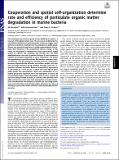Cooperation and spatial self-organization determine rate and efficiency of particulate organic matter degradation in marine bacteria
Author(s)
Nejad Ebrahimi Sardoroud, Mohammad Ali; Schwartzman, Julia A.; Cordero Sanchez, Otto X.
DownloadPublished version (1.272Mb)
Publisher Policy
Publisher Policy
Article is made available in accordance with the publisher's policy and may be subject to US copyright law. Please refer to the publisher's site for terms of use.
Terms of use
Metadata
Show full item recordAbstract
The recycling of particulate organic matter (POM) by microbes is a key part of the global carbon cycle. This process is mediated by the extracellular hydrolysis of polysaccharides, which can trigger social behaviors in bacteria resulting from the production of public goods. Despite the potential importance of public good-mediated interactions, their relevance in the environment remains unclear. In this study, we developed a computational and experimental model system to address this challenge and studied how the POM depolymerization rate and its uptake efficiency (2 main ecosystem function parameters) depended on social interactions and spatial self-organization on particle surfaces. We found an emergent trade-off between rate and efficiency resulting from the competition between oligosaccharide diffusion and cellular uptake, with low rate and high efficiency being achieved through cell-to-cell cooperation between degraders. Bacteria cooperated by aggregating in cell clusters of ∼10 to 20 µm, in which cells were able to share public goods. This phenomenon, which was independent of any explicit group-level regulation, led to the emergence of critical cell concentrations below which degradation did not occur, despite all resources being available in excess. In contrast, when particles were labile and turnover rates were high, aggregation promoted competition and decreased the efficiency of carbon use. Our study shows how social interactions and cell aggregation determine the rate and efficiency of particulate carbon turnover in environmentally relevant scenarios. Keywords: microbial cooperation; self-organization; marine microbes; particulate organic matter; public goods
Date issued
2019-10Department
Massachusetts Institute of Technology. Department of Civil and Environmental Engineering; Parsons Laboratory for Environmental Science and Engineering (Massachusetts Institute of Technology)Journal
Proceedings of the National Academy of Sciences of the United States of America
Publisher
Proceedings of the National Academy of Sciences
Citation
Ebrahimi, Ali, Julia Schwartzman, and Otto X. Cordero. "Cooperation and spatial self-organization determine rate and efficiency of particulate organic matter degradation in marine bacteria." Proceedings of the National Academy of Sciences of the United States of America, 116, 46 (November 2019): 23309-23316. © The Author(s).
Version: Final published version
ISSN
0027-8424
1091-6490